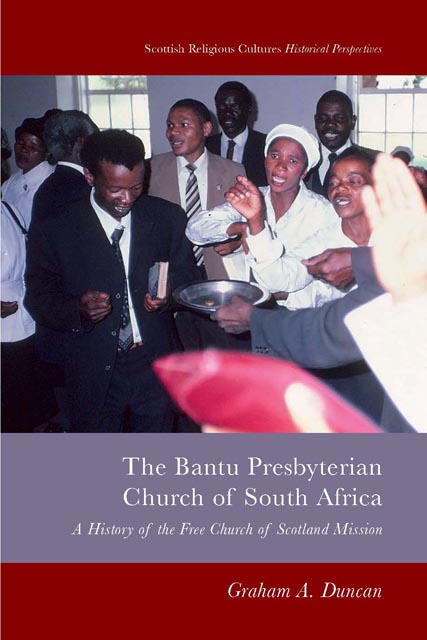Book contents
- Frontmatter
- Contents
- Acknowledgements
- Timeline
- A Presbyterian Anthem
- Introduction
- 1 Background to this Study
- 2 The Origins and Early Development of Scottish Presbyterian Mission in South Africa, 1824–65
- 3 Rev. Tiyo Soga (1829–71): A Paragon of Early Indigenous Leadership
- 4 The Role of Mission Councils in the Scottish Mission in South Africa, 1864–1923
- 5 The Rev. Edward Tsewu’s Dispute with the Free Church of Scotland Mission
- 6 The Mzimba Secession, 1898: A South African ‘Disruption’
- 7 Presbyterianism in South Africa, 1897–1923: To Unite orNot to Unite?
- 8 Preparations for the Formation of the Bantu Presbyterian Church of South Africa, 1897–1919
- 9 The Formation of the Bantu Presbyterian Church of South Africa, 1920–3
- 10 Mission to Church – Church to Mission: The First Ten Years, 1923–33
- 11 Reaching Out: The Bantu Presbyterian Church in South Africa and the Presbyterian Church of South Africa and Ecumenism, 1923–39
- 12 The Bantu Presbyterian Church in South Africa and Ecumenism, 1940–99
- 13 The End of Mission Councils: The Church of Scotland South Africa Joint Council, 1971–81
- 14 A Young Church in Mission or Maintenance Mode?: The Bantu Presbyterian Church of South Africa, 1923–99
- 15 The Bantu/Reformed Presbyterian Church and Socio-political Issues
- 16 Bantu/Reformed Presbyterian ChurchWomen in Leadership in Ministry
- Conclusion: Indigenous Presbyterians and Missionaries –Transferring Contending Roles and Responsibilities
- Bibliography
- Index
9 - The Formation of the Bantu Presbyterian Church of South Africa, 1920–3
Published online by Cambridge University Press: 26 November 2022
- Frontmatter
- Contents
- Acknowledgements
- Timeline
- A Presbyterian Anthem
- Introduction
- 1 Background to this Study
- 2 The Origins and Early Development of Scottish Presbyterian Mission in South Africa, 1824–65
- 3 Rev. Tiyo Soga (1829–71): A Paragon of Early Indigenous Leadership
- 4 The Role of Mission Councils in the Scottish Mission in South Africa, 1864–1923
- 5 The Rev. Edward Tsewu’s Dispute with the Free Church of Scotland Mission
- 6 The Mzimba Secession, 1898: A South African ‘Disruption’
- 7 Presbyterianism in South Africa, 1897–1923: To Unite orNot to Unite?
- 8 Preparations for the Formation of the Bantu Presbyterian Church of South Africa, 1897–1919
- 9 The Formation of the Bantu Presbyterian Church of South Africa, 1920–3
- 10 Mission to Church – Church to Mission: The First Ten Years, 1923–33
- 11 Reaching Out: The Bantu Presbyterian Church in South Africa and the Presbyterian Church of South Africa and Ecumenism, 1923–39
- 12 The Bantu Presbyterian Church in South Africa and Ecumenism, 1940–99
- 13 The End of Mission Councils: The Church of Scotland South Africa Joint Council, 1971–81
- 14 A Young Church in Mission or Maintenance Mode?: The Bantu Presbyterian Church of South Africa, 1923–99
- 15 The Bantu/Reformed Presbyterian Church and Socio-political Issues
- 16 Bantu/Reformed Presbyterian ChurchWomen in Leadership in Ministry
- Conclusion: Indigenous Presbyterians and Missionaries –Transferring Contending Roles and Responsibilities
- Bibliography
- Index
Summary
Preparations for a New Birth
In 1920, two United Free Church of Scotland FMC deputies, Rev. Frank Ashcroft and Mr Andrew Houston, were sent to South Africa to deal with the issue of bringing together the two branches of the Scottish Mission in South Africa. Burchell (1977: 55) points out one innovation in the approach adopted by the Deputies: ‘they came prepared to listen to the demands of these [black] ministers’ and this may have been the actual catalyst for the resulting change of policy with regard to establishing a black church. During his visit, Ashcroft addressed the 1920 General Assembly of the PCSA in support of uniting the missions. As a result, Rev. J. Pollock of the PCSA proposed that:
This Assembly in view of the strong desire of the United Free Church of Scotland, … to have the congregations connected with their missions in Kaffraria and the Transkei united under one ecclesiastical authority, agrees to give the Presbyteries of Kaffraria and Mankazana full power to decide on the question of union with the Synod of Kafraria, leaving for future consideration the relationship to be established between the enlarged body thus formed, and this Presbyterian Church of South Africa. (PCSA General Assembly Minutes 20/9/1920, Ac 1971/Ahl.3.–1.4., William Cullen library [WCL], Wits University, 225)
The PCSA unanimously agreed to this proposal and appointed members to attend a Conference at Blythswood Institution on 20 October 1920. It is unclear why they were there as they were not part of the negotiations (Vellem 2013: 151–2). Also present were representatives from the Mission Synod of Kafraria, the Presbyteries of Kaffraria, Mankazana and Natal, and the Mission Council of Natal. This Conference was called to resolve the anomalous situation which had arisen over the existence of the two separate branches of the UFCoS mission and the deputies urged accordingly. They had come to the conclusion that the relationship with the PCSA could be dealt with at a later stage because it was no longer considered a vital part of having one mission entity to deal with. The Commission on union was well balanced in terms of black and white, ministers and elders with the preponderance of elders being white.
- Type
- Chapter
- Information
- Bantu Presbyterian Church of South AfricaA History of the Free Church of Scotland Mission, pp. 111 - 122Publisher: Edinburgh University PressPrint publication year: 2022



